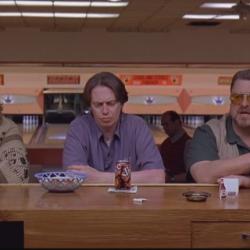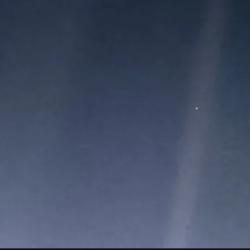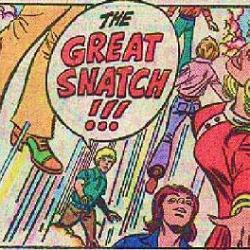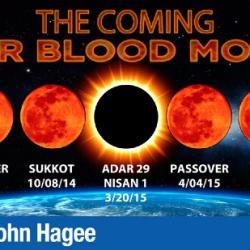Originally posted November 14, 2008.
You can read this entire series, for free, via the convenient Left Behind Index. This post is also part of the ebook collection The Anti-Christ Handbook: Volume 1, available on Amazon for just $2.99. If Trump fires Robert Mueller, I’ll be hollering and marching at the West Chester County Courthouse. Find your nearest protest site here. Volume 2 of The Anti-Christ Handbook, completing all the posts on the first Left Behind book, is also now available.
Left Behind: The Movie [2000] has conveniently been divided into 11 parts for posting on YouTube. This neatly provides us with stopping points as well as the ability to watch together as we work our way through the movie.
[Note: That 11-part bootleg is no longer on YouTube, but the entire 2000 movie is here. You can still watch along if you’re masochistic enough to want to do so.]
We have some cause for optimism as we begin. Yes, there’s the Kirk Cameron factor, but that might not be insurmountable. Lost Boys featured both Coreys, and who doesn’t like Lost Boys? And as bad as the source material for this movie is, it’s often the case that bad books make better movies.
Probably the biggest difficulty in the usual novel-to-movie transformation is that a novel is much, much longer than a movie. A novel like David Copperfield or Huckleberry Finn might work as a six-part miniseries, but not as a two-hour movie. Then there’s the difficulty of translating prose to pictures, of trying somehow to preserve the narrative voice of the novel in a medium where that voice is no longer pre-eminent. (For a glorious illustration of and surrender to this problem, see Tristram Shandy: A Cock and Bull Story.)
Neither of these is particularly troublesome when adapting a bad novel for the screen. Bad novels are filled with unnecessary and extraneous material a director will be eager to cut, so length isn’t an issue. And bad novels usually have no distinct narrative voice — at least not one worth worrying about preserving.
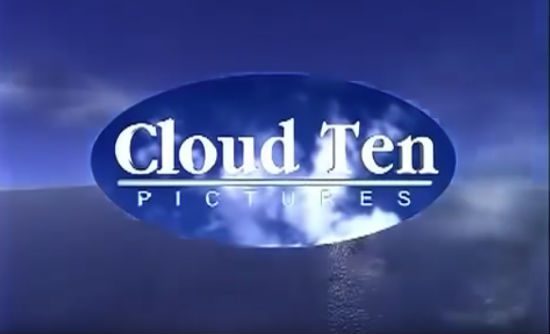
Left Behind thus seems eminently adaptable. The characters are paper thin and the novel’s themes, to the extent it has any, are despicable, so I don’t know why anyone might want to adapt it into a movie. But the task itself seems easy enough. And seeing even this same dismal material reworked by any hand other than those of LaHaye and Jenkins has to be some kind of improvement.
So like I said, I approach this film with a slight optimism. Let’s dim the lights and start the projector.
We open with a voiceover narration, by Cameron — two strikes right there. But this material isn’t from the book, which is promising, and even though it’s mostly just a vaguely foreboding series of non sequiturs —
— it’s the general sort of thing one often hears at the beginning of passable post-apocalyptic horror/thriller B-movies. So one can still hope, at this point, that we might be in for a workmanlike retread of genre conventions. That would be a massive improvement on the book itself. The otherwise hackneyed sunrise-from-space visual accompanying this voiceover adds a touch of originality by seeming to suggest the earth rotating from north to south.
Fade in, we see the iconic view of Jerusalem — looking down from the Mount of Olives east of the city, the morning sun glints off of the eastern face of the golden Dome of the Rock. The time and location appear in text in the lower corner of the screen, X-Files style (complete with the rat-a-tat dot-matrix printer sound effect). “Jerusalem 6:00 p.m.,” it reads.
And now we know that we’re watching a faithful adaptation of Left Behind. Less than two minutes in and the director has already lost track of whether it’s night or day.
The soundtrack drones something vaguely Middle Eastern-sounding and we get the director’s stock-footage slideshow of various Jerusalem landmarks at various times of day — the Damascus Gate and Jaffa Gate near noon, the Western Wall in late afternoon — over which the opening credits roll.
Kirk Cameron gets top billing, so now we know that director Vic “One Drop Can Kill You” Sarin isn’t going to try to maintain Jenkins’ pretense that Rayford Steele shares an equal place in the spotlight.
Steele is played by Brad Johnson. Not a household name, perhaps, but a competent working actor. He’s the guy you want to get once you realize you couldn’t get Tom Berenger.
Third billing goes to Chelsea Noble — a.k.a. Mrs. Kirk Cameron — who plays Hattie. (So now we get to picture Chelsea Handler as Meta-Hattie.) Clarence Gilyard Jr. will be playing the Rev. Bruce Barnes. You probably missed him as “Sundown” in Top Gun, but you may recognize him as Chuck Norris’ sidekick from Walker, Texas Ranger. And my personal favorite in this film, Gordon Currie, who plays Nicolae Carpathia like he’s auditioning for the role of Tim Curry.
Even though this credit sequence is one long establishing shot setting up Jerusalem as our location, we fade to black and fade back in somewhere else. And no, we never do return to Jerusalem. Jerusalem, it turns out, was just the setting for the credits.
Rat-a-tat, “Iraq 6:03 p.m.” The time-stamp is believable this time because we see the sky filled with fighter planes heading west, into the setting sun. They spent some money on the CGI here — those fighter planes appear more or less plausible.
And then suddenly, rat-a-tat, “Syrian-Israeli Border 6:03 p.m.” Swarms of helicopters, tanks and fighter planes are heading east, their shadows stretching out before them as they race across the terrain.
The point here, I think, is supposed to be that the enemies of Israel are rushing to attack her without warning, so it’s a bit unhelpful to be showing us tanks and fighter planes that appear to be heading from Israel and into Syria.
Rat-a-tat “Mediterranean Sea 6:04 p.m.” — the sky is filled with fighter planes flying low in formation. They’re headed toward the top of the screen and the sun appears now to be directly overhead, but I think at this point we’re going to have to agree to stop paying attention to things like direction and the position of the sun. Let’s just agree that there are warplanes racing to attack Israel from the east and from the west, as well as tanks driving to attack Israel from the, um, west.
Sarin is just trying to stay true to L&J’s pliable sense of geography.
We fade back in to Kirk Cameron standing in a wheatfield, wrapping up what seems to be an on-location report for TV news. Making Buck Williams a TV reporter rather than a print journalist seems like a shrewd decision, as does opening with this scene — the sneak attack on Israel miraculously swept away by divine intervention. In the book this scene is told early on, in flashback.
“And as the world faces the most serious food shortage in history,” Cameron/Cameron says, “perhaps there is a ray of hope. I’m Buck Williams, and I’m standing in a wheat field in the middle of the Israeli desert.”
See how that works? You make your protagonist a TV reporter and he can simply announce the setting — no need for a rat-a-tat locator tag and no need for a set more elaborate than a bit of wheat, a random camel, and some Bedouins who seem to be making their camp in the middle of Rosenzweig’s wheat field.
Buck turns to our favorite mad scientist, Dr. Rosenzweig (character actor Colin Fox, whom you’ll recognize even if you can’t quite say from where). “Dr. Rosenzweig,” he says, “It looks like Iowa.”
Wheat, corn; corn, wheat. Close enough.
Cam-Cam says something about every nation wanting Rosey’s secret formula due to “the recent crop failures,” and the doctor says that it’s not for sale. “All I want,” he says, “is peace for Israel.” And, of course, as we hear the words “peace for Israel” we also hear the engines of incoming fighter planes. This is an almost artful presentation of one of Left Behind’s political themes: talk of peace leads to war.
They look up to see the CGI armada of warplanes and start to run for cover when several of the planes drop out of formation and begin dropping bombs on them. Because, you know, two guys and a cameraman in the middle of a wheat field in the middle of the desert present an irresistible strategic target. The explosions are pretty spiffy and it’s very exciting watching Doc and CamCam and the camera guy and soundman dodging precision bombs as they dash toward an ancient-looking building where they hope to find cover.
That ancient building, it turns out, has a really big basement in which is hidden what seems to be the Israeli equivalent of NORAD. This thing is like the Tardis — bigger on the inside than the outside. And no one there seems to have any qualms about Buck just wandering in to the apparent central command for the Israeli Air Force.
Buck and the Doc just mosey over to watch as the various Israeli generals race to scramble their defenses, standing around the inevitable Big Giant Map. We get some shouted dialogue — in Hebrew with English subtitles — before Rosenzweig explains the situation. He’s a botanist, so he’s completely at home in a military command center.
“A full-scale air attack,” he says. “No warning.” And no indication of who the invaders might be. “It could be anyone,” he says. “No one has more enemies who want to see her destroyed than Israel.”
That’s an interesting bit of fudging there. In the book, the invading air forces were from Russia and Ethiopia because the authors insisted this was what the book of Ezekiel unambiguously prophesied. Ezekiel’s meaning seems to have gotten a bit murkier between the time the book was written and when the film was produced. They do keep another bit from Ezekiel, though, the bit about Israel’s enemies being so numerous as to blot out the sun. That language was clearly not intended to be figurative, so as Buck and Chaim are running toward the rickety wooden doors of the military command, we see the sky grow black and the sun disappear.
The enemy planes begin to explode at the Hand of God. Doc and Cam-Cam are watching the attack on giant radar screen/oscilloscope that shows lots of those little radar-screen dots indicating the incoming planes. When the planes start exploding, the radar screen shows little radar-screen explosions.
“Those planes are coming down but we haven’t fired a shot. It’s not possible,” Rosenzweig says. “They’re jamming our monitors. It’s a cruel trick.”
“Only one way to find out,” Buck says. He grabs the camera and microphone from the floor, where they had been abandoned by his suddenly nowhere-to-be-seen crew and he runs outside. Slightly lower-budget explosions fill the sky (it looks a bit like a scene from the original Battlestar Galactica — I’m not sure I didn’t catch a glimpse of Dirk Benedict’s old viper in there somewhere). In a Geraldo-esque move, Buck points the camera at himself, tilting it upwards to catch some of the sky behind his head, but keeping the journalistically essential image — his face — in the center of the screen. It’s the Cam-Cam-cam!
We cut to what I guess is the control room of his TV network, which looks more like NASA’s Mission Control in Houston, with dozens of people watching Buck’s report on a bank of tiny screens. Some unidentified lady with ashes on her forehead leans forward and whispers, desperately, “Get out of there, Buck!” It’s not clear if she’s urging him to flee to safety, or if she means he should get his enormous head out of the shot so that the world can get a better look at the actual story.
Then Buck, who seems to be broadcasting live to the entire world, says, “I’ve been informed by top-ranking military officials that Israel has been unable to launch even a single plane in defense.”
This is why NORAD doesn’t let foreigners with satellite-broadcasting equipment just wander in to their central command. You shout something, some botanist translates it for them, and the next thing you know your military secrets are being broadcast to the entire world by some hack reporter who acts like you’d just sat down with him for an interview.
No one at the TV network seems to respond to the substance of the story Buck is standing in front of. Nor do they seem compelled to respond — they’re not rushing around the way you’d think maybe a TV newsroom might if they’d just learned World War III was starting. Instead, they stare rapturously at their star reporter and gush his praises, their voices choked with emotion:
“Buck would’ve filmed Hiroshima from ground zero if he’d been there.”
“Yeah, that’s our Buck.”
Here, as in the novel, we learn that our heroes are totally awesome by the subtle device of constantly having other characters say that our heroes are totally awesome. Here, as in the novel, this doesn’t work.
I can’t help but see a parallel here between the kind of journalism we’re seeing Buck practice here and the kind of evangelism that we see practiced by Cameron, LaHaye and Jenkins in real life. Buck seems to think that he’s the story here. “I’m Buck Williams and I’m standing …” He’s got a camera, but instead of using it to show the explicit miracle occurring behind him, he uses it to show himself earnestly telling us about that miracle. I’d like to see the miracle, but Buck is standing in the way. Get out of there, Buck!
Anyway, Cam-Cam makes one final, inept attempt at some kind of “This is London” sign-off when he’s interrupted by the arrival of the Mysterious Man in the Prophet Costume. The MMPC recites a snippet from the book of Daniel in a flat monotone — as though he’s afraid any inflection in his voice might cause his fake beard to fall off — and then, just as mysteriously, he hobbles away.
The verdict so far: Incoherent, careless and dull, but still better than the book.
Next week: Meet the Steeles.



